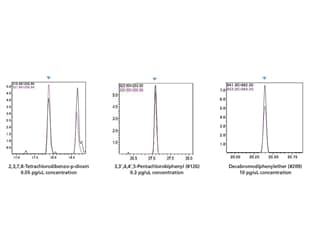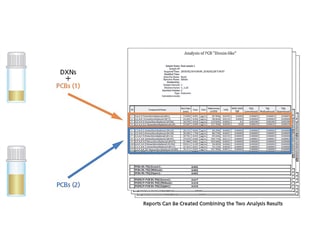EU Regulation Compliant GC-MS/MS Method Package for Dioxins in Foods

Supports the Analysis of Dioxins in Foods Using GC-MS/MS
The analysis of dioxins in foods was mainly performed using magnetic sector (double-focusing) GC-MS instruments. However, in June 2014, the GC-MS/MS method was officially recognized in the EU as being equivalent to the magnetic sector GC-MS method (EU 589/2014). This product consists of method files for the analysis of dioxins in foods, and a report creation tool, supporting the analysis of dioxins via GC-MS/MS.
Features
-
Optimized analysis conditions (including transition and collision energy) are pre-registered in this product's method...
-
Reports of the analysis of dioxins in foods must contain the results of complicated calculations. Included...
News / Events
-
Latest issue of Shimadzu Journal, featuring Environmental Analysis, has come out.
This issue showcases advanced technologies and research tackling the global challenges posed by PFAS. As part of Shimadzu’s ongoing commitment to sustainability and problem solving, we strive to reduce environmental impacts and build a better future.
-
Automatic Derivatization System for Phenethylamine Drugs
This system allows the on-column derivatization using auto-injector AOC-30i and a LabSolutions GCMS system that is now equipped with 2-step injection. On-column derivatization allows for the direct analysis of extracted urine samples without additional sample pretreatment, which can significantly shorten the time required for derivatization.
-
AOAC INTERNATIONAL Posters are now available.
-
Shimadzu has released the GCMS-QP2050
The next-generation GCMS-QP2050 gas chromatograph mass spectrometer, with its accumulation of impressive Shimadzu technology, will lead the way forward. New value is provided by hardware boasting astounding reliability and stability, and easy-to-operate software equipped with superior automated technology.
-
Solutions for Analysis of Ethylene Oxide and 2-Chloroethanol in Food
Even though Ethylene oxide (EtO / EO) is well-known to be a toxic compound with carcinogenic and mutagenic concerns, it has been widely used for fumigation in the food industry because it effectively reduces or eliminates microbiological contamination with bacteria/fungi. The recent recall of food products exported to the EU due to non-compliance with EU regulations has highlighted the importance of quantitation of EtO and 2-CE residues in food.
-
Latest issue of Shimadzu Journal, featuring Forensics / Toxicology, has come out.
This issue focuses on "Forensics / Toxicology", an area where science and technology are particularly important and needed. It starts with two customer interviews.




